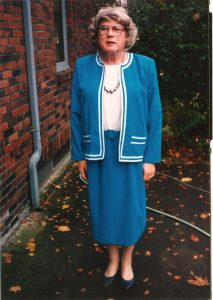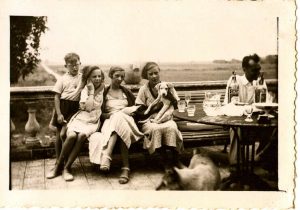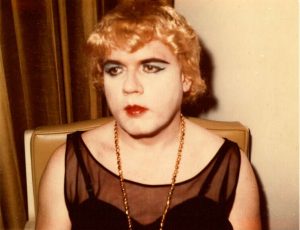The Enigma of Dr. Ellsworth
By Ross Eliot
Most college students never stand awkwardly on their stark naked history professor’s front porch after being invited to live in the pantry, but nothing connected with Dr. Ellsworth could ever be called ordinary.
I moved to Portland, Oregon from Seattle in 1998 at age twenty-two; a pale subculture kid whose liberty spiked mohawk only folded down to fit under my motorcycle helmet. Before long, I signed up for classes at the local community college. Western Civilization quickly became a favorite because of the professor, Dr. Babette Ellsworth. She stood around five-foot-eight, bulky and wide shouldered, with shrewd eyes that peered through thick glasses. Her ill-matched tops rose above black thigh-high stockings and each word resounded in a deep French accent. Everyone speculated about her before class, a professor whose age even seemed mysterious. Was she fifty-five? Seventy-five? An American? Really a man?
Despite Dr. Ellsworth’s odd appearance, everyone fell still once her lectures began. Possessing an incredible memory, each fact flowed from her without notes or reference materials. She specialized in sordid historical details, the passions that filled everyone from peasants to popes and presidents. One day, my professor pulled me aside. She confessed to poor health and desired a live-in caretaker. After only momentary hesitation, I accepted her offer.
Just a few days later, I waited on her elegant doorstep in one of Portland’s posh neighborhoods, meagre belongings at my feet. When the door opened, Dr. Ellsworth stood before me, fresh from the bathtub, dripping wet and bare. She apologized for this unexpected welcome and I soon discovered my professor considered clothes an inconvenience only tolerated in public. At least, this spectacle answered some of my previous curiosity regarding her gender. Dr. Ellsworth indeed seemed female.
Yet questions remained. Much household mail came addressed to Albert Ellsworth. My professor smiled mischievously when I asked about this. Albert? Oh, he was my husband. Some people suspected I had him murdered. This suggestion made her laugh. However, over the next several years, while I lived in Dr. Ellsworth’s basement pantry and provided caregiving as her leukemia worsened, the actual story emerged. Albert and Babette were indeed one person until 1994, when my professor surgically transitioned at the advanced age of sixty-six. Surprising revelations only began there.
Albert Ellsworth was born in Yakima, Washington to a teenage mother in 1928. For reasons that remain murky, Albert fell under the care of a wealthy French woman named Germaine Bonnefont and her American husband, Robert Brown. Two years later, this couple traveled to France with their unofficially adopted son. Robert Brown came back to the US soon afterward, but died from falling off a horse in 1932. Germaine then raised Albert amidst circumstances as far removed from depression era Eastern Washington as another universe.
High society in southern France attracted upper class members from all over Europe. Many surviving Russian aristocratic families chose that area to re-settle after the anti-monarchist revolution scattered them following WWI. The Bonnefonts were well connected politically and hosted quite a number of these exiles. In particular, my professor remembered a nobleman named Prince Felix Yusupov, known to history as the murderer of Rasputin in 1916. Oh, he had terrible breath and smelled so strongly of cigars!
The Bonnefont clan centered around a large mansion in the Sigean region near Narbonne called the Chateau du Lac. This was close enough to Spain that young Albert soon learned Spanish, as well as French. He attended Catholic school and even became an altar boy, posing for many pictures in the ceremonial gown of his office. This immersion in religion started a lifelong obsession for Albert.
Like many French families, the Bonnefont’s nursed an age-old grudge against England. After the first round of WWII ended with defeat by Germany, they found new purpose supporting Marshal Petain’s government. While history considers supporters of Petain’s Vichy regime to be Nazi-collaborators, my professor and her family simply saw themselves as patriots, opposing Communism that had already wiped out millions and threatened to sweep over Europe. They picked the wrong side. As WWII ended, France descended into fierce civil conflict and many Bonnefonts were among thousands killed by their own countrymen. Later photographs of the Chateau du Lac show it destroyed, a crumbling, burned-out shell.
1945 found Albert in Paris, a lost seventeen-year old youth amidst countless displaced persons, desperate refugees and other human detritus washed up by reseeding tides of industrial scale warfare. As the new French government came into power, his identity fell under scrutiny and officials determined he properly belonged in Yakima. My professor remembered this deportation felt like a trip to the moon and even decades later bitterly complained how New York customs confiscated her portrait of Hitler.
Albert found little comfort in Eastern Washington and soon ran away from his birth family to Portland. His incredible intellect already showed great potential. By 1949, he earned a four-year degree from Portland University, a Catholic school. Around this time period, his eventual transformation already left evidence. Photographs show Albert in drag, his broad torso bound up with lace and silk, heavy-handed makeup across eyes and cheeks. He is always alone, backgrounds showing flimsy furniture and threadbare carpets in cheap motels. The exceptions are religious. Albert daringly stands outside churches and cathedrals, draped in ill-coordinated feminine outfits with wigs perched on top of his large round head.
This aspect of Albert’s life remained secret until he at last possessed the resources to undergo full sex-reassignment surgery. My professor loved shocking people and one of Babette’s colleagues well remembered the day Albert announced at school with no warning whatsoever: I am going to become a woman! I shall live as a lesbian!
Nothing impassioned Dr. Ellsworth more than her work and she taught up until the day she died, dropping dead from a heart attack in front of forty students at Portland Community College on February 16th, 2002. I will always treasure our relationship and honor her, as a dear friend, gifted historian and pioneer toward greater acceptance for the transgendered.
Category: Transgender History







